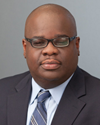Professor examines how diversity offices form, evolve on college campuses
LAWRENCE — College campuses across the country have shown in the past year how vital concerns about diversity and equity are in higher education. While many institutions have offices or administrators charged with overseeing diversity efforts, little attention has been paid to how and why what is commonly referred to as the Chief Diversity Office is formed on campuses. A University of Kansas professor has authored a study examining the formation and evolution of such offices at institutions of higher education.
 Eugene Parker, assistant professor of educational leadership and policy studies at KU, has authored a study examining how Chief Diversity Offices were formed at two American research-intensive universities and how the roles of the offices compare to what is known about diversity offices in higher education. Parker found that while there is no standard for such offices they do share many of the same traits and challenges.
Eugene Parker, assistant professor of educational leadership and policy studies at KU, has authored a study examining how Chief Diversity Offices were formed at two American research-intensive universities and how the roles of the offices compare to what is known about diversity offices in higher education. Parker found that while there is no standard for such offices they do share many of the same traits and challenges.
Previous research has shown that offices dedicated to overseeing diversity efforts are often created in response to some sort of racial incident. In the case of the two universities in Parker’s study, referred to as Southern and Northern Eastern University, the chief diversity offices were not in fact formed in response to an incident but in response to ongoing awareness of an unfavorable climate for equality. Following the larger trend in higher education, the two institutions did not have an immediately clear vision of who should oversee the diversity efforts on campus.
“There are changing demographics on campuses and more people are paying closer attention to diversity,” Parker said. “Yet we don’t really know who should be overseeing diversity efforts or leading them. Across universities there is no standard. Some would say it’s everybody’s responsibility, while others would say having an executive helps by putting it in the hands of one leader.”
Nationally, the offices generally form at the urging of stakeholders on campus, as opposed to outside governing bodies. Generally the advocates come in the form of faculty or students. That was true of the universities in the study, with faculty being the main proponents.
The lack of standards has also led to title, rank, pay and duties of chief diversity officers being largely different from one campus to another. That was true of Southern and Northern Eastern Universities as well. One office was largely tasked with focusing on student success, while the other paid considerable attention to assessment. Previous research has shown that just over half of CDOs have affirmative action responsibilities and the study reflected that, as one of the two offices had such responsibilities.
Both universities reported having a president that was receptive to diversity efforts and supportive of the office’s mission, matching national findings that supportive leadership aids in the formation of diversity offices. Nationally, reporting lines for such offices vary and that held true in Parkers’ study as well, as one CDO reported directly to the president while the other reported to a provost. Previous research has suggested it is important for CDOs to report to a president, but that was not reflected in the findings, as both offices felt their offices were effective and their efforts were deemed important by university leadership. That suggests a university’s individual climate may be most important in determining appropriate reporting lines, Parker said.
“We wanted to ask, ‘Is there a difference in sitting at the president’s table and a CDO who reported to some other administrator?’” Parker said. “We found that context matters in this question. Not reporting directly to the president seemed to work.”
Despite differences in duties, reporting lines and formation, both institutions reported being hindered by budget. Even though Northern Eastern University’s budget was nearly double that of Southern University, both Chief Diversity Officers said they were hindered in fulfilling their mission by a lack of financial resources.
Understanding the challenges, incentives for formation and successes of CDOs have numerous implications for university administrators, Parker said. The universities in the study counteract the national narrative that such offices are hastily formed in response to racially charged incidents. While there are no standards in duties or reporting lines, understanding an individual campus’ culture is vital in assigning such, the findings suggest, as efficacy of the offices depend on such.
Above all, the lack of a consistent, coherent understanding of what diversity means is likely the biggest challenge to forming effective efforts to ensure effective efforts to ensure diverse and equitable experiences at American colleges and universities.
“The formation of a chief diversity office and the persistent unclear conceptions of diversity muddle the capacity of the office to realize its goals,” Parker wrote. One might infer that broad or indistinct conceptions of diversity produce indistinct roles and functions of chief diversity offices.”
Parker has presented findings from related diversity studies at the Association for Study of Higher Education and the American Educational Research Association conferences. He is currently conducting research and publishing work examining the role of diversity in a number of other higher ed contexts such as if institutional selectivity has an effect on educational outcomes for students of differing racial backgrounds and if participation in diversity based activities has an influence on cognitive outcomes such as grade point average and critical thinking as well moral development, social leadership and related outcomes.